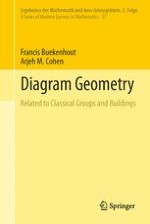This book provides a self-contained introduction to diagram geometry. Tight connections with group theory are shown. It treats thin geometries (related to Coxeter groups) and thick buildings from a diagrammatic perspective. Projective and affine geometry are main examples. Polar geometry is motivated by polarities on diagram geometries and the complete classification of those polar geometries whose projective planes are Desarguesian is given. It differs from Tits' comprehensive treatment in that it uses Veldkamp's embeddings.
The book intends to be a basic reference for those who study diagram geometry. Group theorists will find examples of the use of diagram geometry. Light on matroid theory is shed from the point of view of geometry with linear diagrams. Those interested in Coxeter groups and those interested in buildings will find brief but self-contained introductions into these topics from the diagrammatic perspective. Graph theorists will find many highly regular graphs.
The text is written so graduate students will be able to follow the arguments without needing recourse to further literature.
A strong point of the book is the density of examples.
